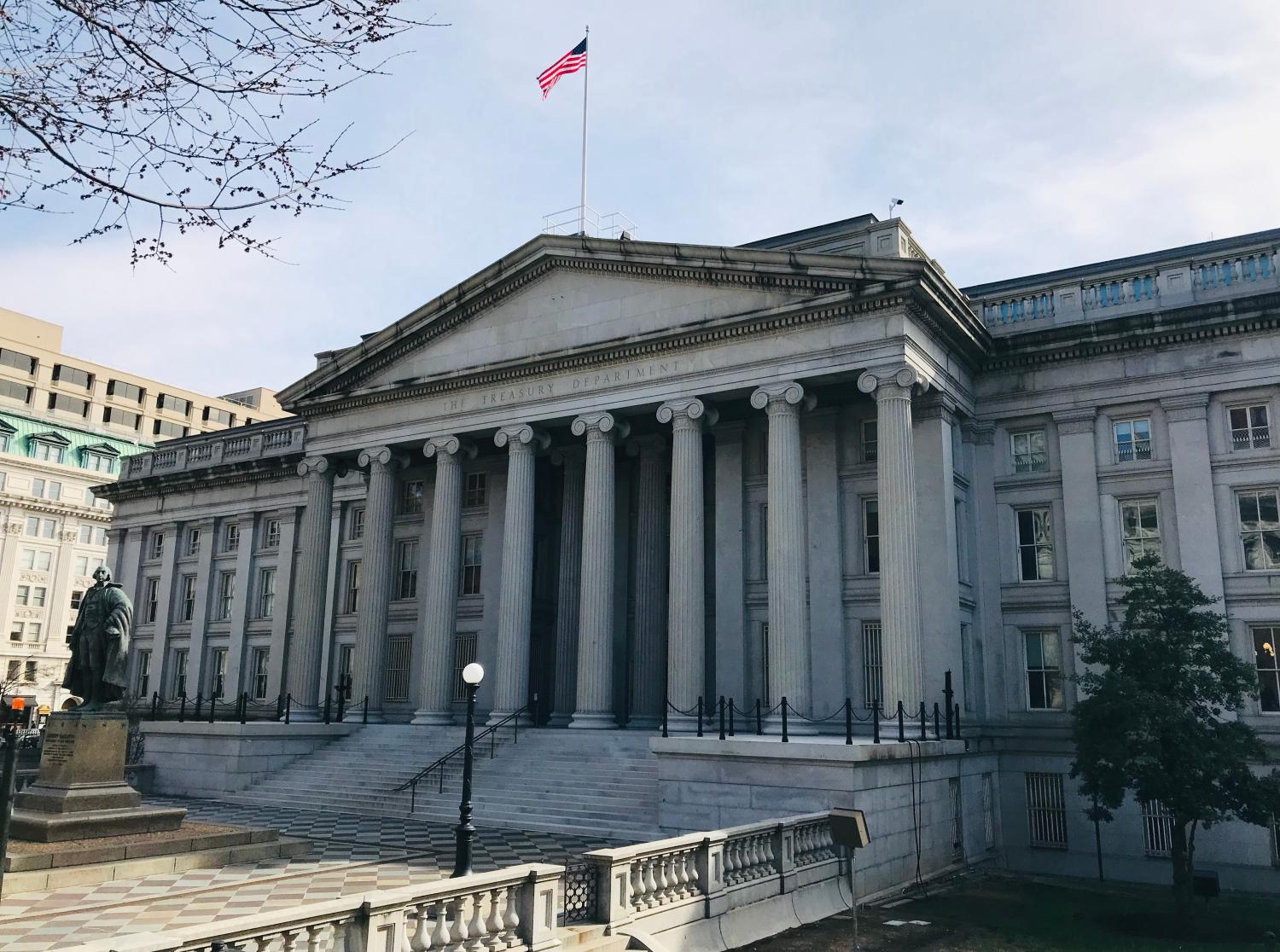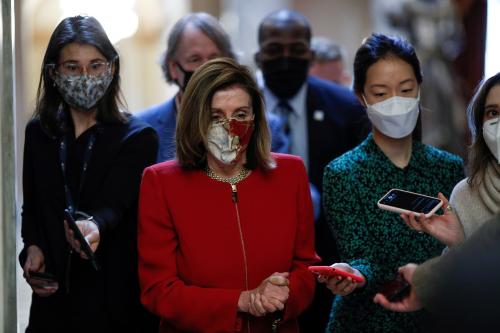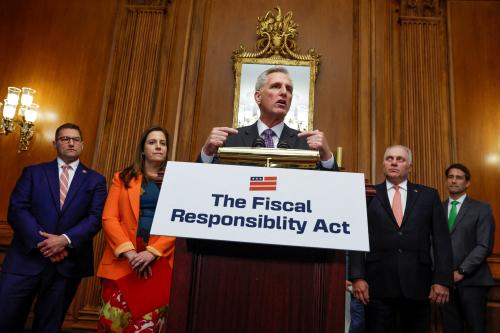This brief is part of the Brookings Blueprints for American Renewal & Prosperity project.
Resilient markets for U.S. Treasury securities are essential to the strength and stability of the U.S. economy. Robust market liquidity reduces the interest rate on federal debt, ensures that Treasuries can be an effective safe haven when asset prices fall, and makes them the benchmark against which risky assets are priced. But recent events have called into question the resiliency of Treasury market liquidity in high-stress periods. For example, in March, as concerns spread about the impact of COVID-19 on the economy, the prices of Treasury securities fell alongside equity and corporate bond prices, breaking the typical flight-to-safety pattern. The Federal Reserve took aggressive, unprecedented actions to restore market liquidity and preserve the special role of Treasury securities.
Financial regulators have started to consider potential regulatory changes that would reduce surges in demand for Treasury market liquidity under stress, especially by non-bank financial entities.1 But the underlying problem is bigger than can be addressed solely by measures to reduce demand. We propose measures intended to increase the supply of bond market liquidity in times of stress. Reforms must address a fundamental structural change in the U.S. financial system: In recent years the rapid growth of the U.S. Treasury and other U.S. bond markets has outstripped the capacity of dealers, the traditional suppliers of liquidity, to meet liquidity demands in stress periods. Federal Reserve Board Vice Chair for Supervision Randal Quarles recently said that the rapid expansion of Treasury market debt in recent years “may have outpaced the ability of the private-market infrastructure to support stress of any sort.”2
To enhance market liquidity in stress periods, we propose four complementary measures.3First, a new Federal Reserve standing repo facility that would serve as a backstop for the U.S. financial system by providing funding to regulated dealers based on U.S. Treasury and agency collateral; second, serious consideration of a mandate for wider use of central clearing for Treasury securities; third, targeted changes to bank regulations that may be limiting market-making while not materially improving the strength of these firms; and, fourth, collection and disclosure of data to better monitor funding risks and leverage of dealers and non-bank financial intermediation.
These measures would enhance the resiliency of Treasury market liquidity by increasing the market-making capacity of dealers, which would allow them to accommodate clients’ needs in abnormal periods. The measures provide opportunities for smaller independent dealers to expand and could diversify the provision of liquidity on the margin. The measures also could reduce the procyclical pullback in market liquidity provision when asset prices fall.
These reforms are necessary to meet the U.S. economy’s large and growing dependence on market-based financing. The public policy case for a backstop standing repo facility is the same as that for the discount window for banks. By establishing an ex ante facility to act as a lender of last resort to support credit provided by markets, the Fed will help to ensure a stable supply of credit to U.S. households, businesses, and governments and avoid severe contractions of credit in liquidity stress periods. However, a standing facility could create moral hazard, so dealers with access to the facility need to be prudentially regulated, and more information about dealer balance sheets and activities needs to be provided to regulators and to the public. Importantly, these reforms would reduce the likelihood of emergency interventions by the Fed in the future except in extreme circumstances. While the Fed quickly took actions that were necessary and successful in response to the COVID-19 pandemic, the costs of ex post interventions for the Fed and for financial stability are likely to be greater than those under a well-designed backstop repo facility with pre-established rules.
Challenge
U.S. bond markets have grown enormously in past decades (see Figure 1). In addition to the rapid growth in Treasury securities, corporate bonds have grown, outpacing bank loans to businesses, and agency securities remain substantial. Bond financing relies on market liquidity since investors want assurance they can sell a bond if they need to without having a material impact on its price. A growing share of corporate and other bonds are held in open-end funds, which rely on the liquidity of the bonds and Treasury securities to manage liquidity risk. In March, sales by open-end funds of both Treasury securities and corporate bonds to meet unprecedented investor redemptions contributed to the turmoil.4
At the same time, broker-dealers, the traditional market makers, have substantially reduced their capacity since the global financial crisis (GFC), in part because some elements of the post-GFC regulatory framework have discouraged bank-affiliated dealers from allocating capital to market-making. Gross inventory positions of Treasury securities of broker-dealers have fallen significantly, from 10 percent in 2008 to 3.1 percent in 2019 of outstanding bonds. The share of corporate bonds held by dealers is less than one percent, down from eight percent in 2007.5 Smaller inventories and less flexibility to respond to events because of stricter regulations and internal risk management processes suggest a risk of insufficient liquidity provision in stress.
Moreover, the broker-dealer sector is concentrated, and nearly all of the very largest firms are affiliated with G-SIBs. The fact that the liquidity of these enormous markets depends on such a small set of such dealers raises concerns regarding market efficiency and financial stability. Given the size of the U.S. Treasury, agency, and corporate bond markets, it is not realistic to expect the existing dealers to maintain the capacity to meet system-wide demands for market liquidity in stress periods, especially if demand spikes only infrequently.
Limits of historic and existing policies
The Federal Reserve functions as the economy’s lender of last resort, providing liquidity to prevent short-term disruptions from creating contractions in credit that can harm the real economy. Currently, only banks (and other insured depository institutions) can access the discount window, the Federal Reserve’s existing standing liquidity facility. That limitation was appropriate when it was mainly banks that provided credit to households and businesses. But for a U.S. financial system that has become heavily dependent on market-based finance, that limitation is now unnecessarily narrow. With more market-based finance, credit provision depends on market liquidity provided largely by broker-dealers that in turn depend on a stable and elastic funding supply through repos.
No dealers have direct standing access to Federal Reserve liquidity. Bank-affiliated dealers have indirect access through their ability to borrow from bank affiliates with access to the discount window. However, for securities other than U.S. government securities, that indirect access is limited by section 23A of the Federal Reserve Act, and financing of Treasury securities is limited by supervisory expectations for resolution planning that discourage dealers from relying on funding from their affiliated banks. During the great financial crisis and the COVID-19 crisis, the Fed expanded access by creating emergency liquidity facilities for the small group of twenty or so primary dealers, allowing them to finance fixed-income securities through repo. This allowed the dealers to continue to fund their customers, supporting the flow of credit during these crises. However, other dealers did not have access even in emergency circumstances.
Currently, only one-third of Treasury transactions are cleared through a central counterparty, limited by the clearing system’s concerns about counterparty risk and some counterparties’ hesitancies to bear the obligations associated with central clearing. While clearing is mandated for many other markets, including equities and Treasury futures, it is not for Treasury securities, and reasons for this distinction are unclear.
The importance of bank regulatory capital constraints cannot be pinned down precisely, but the success of relaxing certain regulations in response to the COVID-19 crisis suggests that they constrained the provision of market liquidity. The Fed’s temporary relaxation of the supplemental leverage ratio (SLR) for bank holding companies in March, which excluded Treasury securities and central bank deposits at the Fed (“reserves”) – which were increasing with the Fed’s emergency liquidity responses – is believed to have helped ease the pressures on dealer balance sheets and thereby contributed to the improvement of market functioning.
Policy recommendations
We propose a four-part reform to enhance the resilience of Treasury market liquidity during stress periods.
A standing repo facility
The first reform that we propose is for the Federal Reserve to create a standing repo facility, which would offer secured financing in stress periods to eligible broker-dealers under pre-established arrangements. Under existing law, the facility would be limited to repos of U.S. government and agency securities (authority is provided by section 14 of the Federal Reserve Act).6 Access to the facility would be open to both independent dealers and to bank-affiliated dealers that applied for access and agreed to meet a common set of prudential regulations established by the Federal Reserve in cooperation with the SEC and that were in sound financial condition. These regulations would be tailored to the size and complexity of the individual dealers, just as banking regulations are currently tailored.
Financing would be provided at interest rates slightly above normal market rates in order to limit use of the facility to periods of stress and to limit excessive reliance by dealers on the standing facility. In addition, financing would be provided to dealers at market haircuts, rather than at higher levels reflecting stress, to avoid amplifying the stress.
A standing repo facility, by providing a reliable source of alternative funding in periods of stress, would allow dealers with access to confidently provide liquidity to markets under stress, assuring them that they can fund any securities they purchase or finance. Combined with tailored regulations, the facility would enable and encourage more dealers to provide bond market intermediation in competition with the current dominant dealers, all of which are affiliates of G-SIBs. Indeed, a critical aim of these initiatives to enhance market liquidity is to reduce the considerable concentration of activity by encouraging more dealers to increase their capacity to provide market liquidity.
Even though financing provided through the facility would be provided at penalty rates, an important and legitimate concern is that the creation of the facility could create moral hazard.7 Dealers with access to the facility might take on excessive leverage and maintain inappropriately small liquidity buffers. They may have less incentive to screen and monitor risks of their clients. As in the case of banks and the discount window, however, this concern could be addressed through prudential regulation of the dealers that have access to the repo facility.
For bank-affiliated dealers, the existing bank regulatory framework already addresses these moral hazard concerns through, among other measures, capital and leverage requirements, regulation of counterparty exposures on repos (and securities loans, which are economically equivalent), and counterparty risk management practices with respect to those exposures. For independent dealers, however, the existing SEC standards alone may not be adequate for firms with access to a Fed standing liquidity facility. To better address the potential moral hazard, the Fed should work with the SEC to develop enhanced standards for those firms.8 Those standards would need to be tailored to the size, business model, and risk profile of the dealers. Encouraging the expansion of other dealers could increase the breadth of liquidity provision on the margin.
Central clearing of Treasury securities
Second, we propose serious consideration of mandated central clearing of Treasury securities, starting with a study as proposed by Duffie (2020). Broader central clearing would increase the supply of liquidity by the largest bank-affiliated dealers by easing constraints from existing capital and leverage requirements. The rules of the CCP should be designed to enhance the ability of smaller bank-affiliated and independent dealers to compete with the largest dealers. It might also eventually enable more all-to-all trading, which could reduce the need for dealer intermediation altogether by permitting investors to provide the flexibility in the system, as in the equity and Treasury futures markets. To be sure, central clearing raises concerns about concentrations of risk in CCPs, so it would make the risk management of CCPs and their regulation even more important.
Targeted bank regulatory changes
Third, we propose certain targeted regulatory changes to allow bank-affiliated dealers to increase the supply of liquidity to markets under stress without reducing their overall safety and soundness. Most importantly, there must be permanent changes to the supplementary leverage ratio (SLR). The modifications that the Federal Reserve made to temporarily exclude U.S. Treasury securities and reserves from the SLR calculation will lapse at the end of the first quarter of 2021. But the Federal Reserve’s balance sheet is now far larger than before the COVID crisis, and it is likely to continue to grow until the economy has recovered from the COVID shock. Thus, rescinding the exclusions would raise capital requirements, and the SLR would likely become the binding constraint on bank-affiliated dealer balance sheets rather than fulfilling its intended purpose as a backstop to their risk-based capital requirements.
We propose that the temporary exemption of reserves from the supplementary leverage ratio be made permanent to reflect the large and growing balance sheet of the Federal Reserve. We posit that because reserve balances at the central bank are riskless, permanently excluding them would be appropriate. In contrast, we do not propose a permanent exclusion of Treasury securities, because they may pose interest rate risk not covered directly by risk-based capital requirements. The Federal Reserve would need to review whether the minimum SLR requirement needs to be increased in light of these exclusions. Alternatively, because any exclusions would make necessary continual evaluation of what is or is not risky, regulators could not permanently exclude reserves and instead lower the minimum SLR. But this alternative would be a less targeted way to enhance the provision of market liquidity and seems more likely to reduce bank safety and soundness.
In addition, we propose replacing some of the higher static buffers of the enhanced SLR (eSLR) with a countercyclical component, which could be released in episodes of market-wide stress to support liquidity of Treasury markets. This would operate much like the new countercyclical capital buffer, which applies to the risk-weighted capital requirements that many countries released in response to the COVID-19 pandemic to support bank lending to households, businesses, and governments.9
Improved data collection and disclosure
Fourth, we propose greater disclosure of the balance sheets and activities of dealers to monitor their financial condition and market shares. Greater disclosure of dealers’ financial conditions and activities could also help to address moral hazard concerns. We also propose collecting data for bilateral uncleared repo, a significant market for dealer-to-client funding, in order to better monitor leverage and funding risks in the nonbank financial sector.
Conclusion
Had these proposals been in place in March, they would have helped the financial system to better respond to the COVID crisis. The standing repo facility would have reduced the intensity of the dash for cash by investors because financing of Treasury securities on pre-specified terms was assured, albeit at penalty rates; dealers would have had greater capacity to meet the surge in demand for market liquidity. We believe the proposals can increase the provision of liquidity without adverse effects on the safety and soundness of dealers; would enable more effective competition with the current dominant dealers; and may reduce reliance on emergency actions by the Federal Reserve.
Patrick Parkinson is a Special Advisor at the Bank Policy Institute—a nonpartisan public policy, research, and advocacy group. The authors did not receive financial support from any firm or person for this article, and other than the aforementioned or activities listed on Nellie Liang’s expert profile, from any firm or person with a financial or political interest in this article. The authors are currently not officers, directors, or board members of any organization with an interest in this article. The views expressed in this piece are those of the authors and do not represent the positions of the Bank Policy Institute or Brookings. No organization had the right to review this work prior to publication.
-
Footnotes
- Financial Stability Board, “FSB Holistic Review of the March Market Turmoil. Virtual Stakeholder Outreach Meeting, 18 September 2020, Annotated Agenda,” 9 September 2020. https://www.fsb.org/2020/11/holistic-review-of-the-march-market-turmoil/
- Reported in “Why the bond market might keep America’s next president awake at night,” Nov. 4, 2020, Economist. https://www.economist.com/finance-and-economics/2020/11/04/why-the-bond-market-might-keep-americas-next-president-awake-at-night
- These proposals are described in more detail in Liang and Parkinson (2020), Hutchins working paper (forthcoming)
- J. Nellie Liang, “Corporate Bond Market Dysfunction During COVID-19 and Lessons from the Fed’s Response,” Brookings Institution, Hutchins Center Working Paper #69, October 1, 2020. https://www.brookings.edu/research/corporate-bond-market-dysfunction-during-covid-19-and-lessons-from-the-feds-response/
- These percentages are from Figure 3 in Liang and Parkinson (2020), Hutchins working paper (forthcoming)
- The Federal Reserve should also consider expanding the standing facility to fixed-income securities that are sufficiently liquid that their values can be reasonably determined in normal times. An expansion might also make use of the facility and its associated prudential requirements more attractive to smaller dealers and facilitate their ability to compete with the current dominant dealers. To be sure, that principle would not imply that the facility can cover all bonds. However, any expansion to other types of bonds in normal times would require new legislation.
- See FOMC minutes for discussion of a standing repo facility to improve the control of the federal funds rate. https://www.federalreserve.gov/monetarypolicy/fomcminutes20191030.htm
- Duffie, Darrell, 2020. “Still the World’s Safe Haven? Redesigning the US Treasury Market After the COVID19 Crisis,” Brookings Institution, Hutchins Center Working Paper #62, June 3, 2020. https://www.brookings.edu/research/still-the-worlds-safe-haven/
- See Edge, Rochelle and Nellie Liang, 2020. “Financial Stability Committees and Basel III Macroprudential Capital Buffers,” Brookings Institution, Hutchins Center Working Paper #56, Jan, updated Nov. https://www.brookings.edu/wp-content/uploads/2020/02/WP56-FINAL-2.9.pdf








